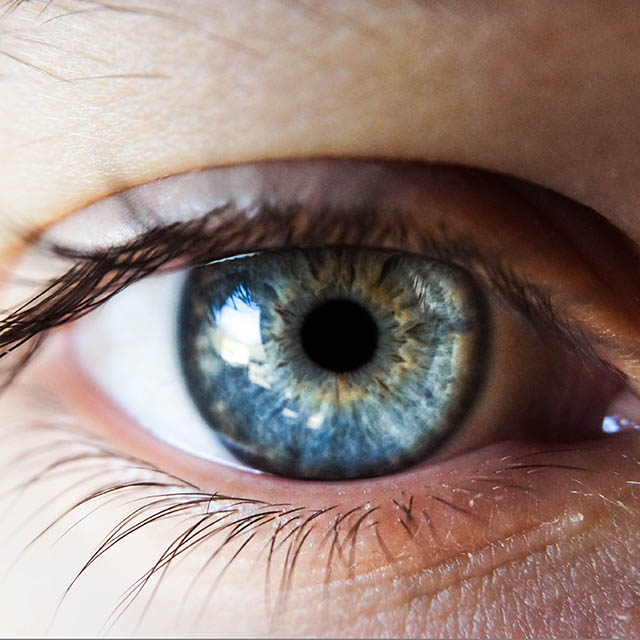What is Binocular Vision Dysfunction (BVD)?
Binocular Vision Dysfunction (BVD) is a serious eye condition where the eyes are misaligned, sending two different images to the brain. The brain struggles to merge these two different images into one clear image, causing symptoms such as headaches, dizziness, anxiety, motion sickness, and chronic neck pain.

Symptoms
BVD can severely impact people of all ages. Children with BVD often struggle with reading in school, hand-eye coordination, playing sports, and car sickness. This condition often leads to misdiagnoses of ADHD, dyslexia, and migraines in children. Adults with BVD regularly experience headaches, daily anxiety and dizziness, and can be severely limited from doing normal tasks or succeeding in the workplace.
The symptoms of BVD are wide-ranging and not often recognized by traditional eye doctors. Those who specialize in treating BVD often organize the symptoms into groups based on how they impact patients:
| Physical Findings:
| Neurological Symptoms:
|
| Binocular Vision Symptoms:
| Reading Challenges:
|
| Driving Symptoms:
| Anxiety Symptoms:
|
What causes BVD?
The condition can be caused by facial asymmetry similar to adults, or it can be caused by a concussion or head injury, such as from a soccer game or falling while riding a bike. Some research suggests that at least 20% of adults experience some symptoms of BVD that may be interfering with their everyday lives. Someone you know may be suffering from binocular vision dysfunction and not even realize it. Exactly why some people develop BVD and others don’t often isn’t clear.
Early research has found that BVD can be genetically inherited and run in families, most often from mother to daughter. In other clinical research, there is a direct correlation between head injury or concussion and the onset of BVD symptoms. There is also a connection between BVD and acquired brain injuries caused by a stroke, Lyme disease, COVID-19, and Mono (Mononucleosis).
Can BVD be misdiagnosed?
Yes, BVD symptoms are often mistaken for a number of other conditions since many medical and eye doctors don’t know how to screen for and diagnose BVD. Patients are regularly but mistakenly told they have one of the following conditions, while in reality BVD is the main cause of their symptoms:
|
|
Find out if you are struggling with BVD: Take the BVD Test
What to expect: The NeuroVisual™ Exam
While at least 20% of the population suffers from Binocular Vision Dysfunction, almost no one knows about this condition. To make matters more difficult, people suffering from BVD have a small amount of vision misalignment not found in a routine eye exam.

How is Binocular Vision Dysfunction diagnosed?
Dr. Wei Zhang has trained in the cutting-edge work of diagnosing and treating Binocular Vision Dysfunction. In addition to the standard eye examination, our doctor provides a comprehensive NeuroVisual™ Exam to uncover the patient’s misalignment and to prescribe specialized microprism lenses. These special lenses align the two images being sent to the brain, allowing for the creation of one clear image and relieving the majority of a patient’s BVD symptoms.
Patients who are suffering from BVD feel noticeably better immediately once they begin wearing their custom-fit pair of microprism lenses. In fact, the average patient will notice a 50% reduction in symptoms by the end of their first visit. Over the next several visits, the prism prescription is fine-tuned and continues to improve and eliminate BVD symptoms.
What tests are performed during a NeuroVisual™ Exam?
A comprehensive binocular vision assessment is the best way to find out if you have binocular vision dysfunction. A NeuroVisual™ trained eye doctor can successfully diagnose BVD through a specialty binocular vision exam designed to assess your entire visual and physical system. In addition to standard eye exam tests, the eye doctor will assess the following:
- Eye movement
- Eye teaming and tracking
- Eye focusing
- Binocular fusion
- Balance and gait stability
- Posture and neck alignment
- Visual convergence
- Visual-spatial awareness
- Blood pressure and heart rate
- Depth perception
Can I still have BVD with 20/20 vision?
Yes, patients can have both 20/20 vision and Binocular Vision Dysfunction. During a routine eye exam, each eye is checked individually, but patients are not regularly assessed for how well their two eyes work together. Patients who see 20/20 have a high level of acuity in each eye, but this measurement doesn’t tell us anything about how the patient’s two eyes are working together as a team (i.e.- binocular vision).
The thorough NeuroVisual™ Exams performed in our clinic evaluate patients’ binocular vision to determine what is causing their BVD symptoms and to custom fit microprism lenses to relieve these symptoms.
For more on binocular vision dysfunction or and to get tested for BVD, take the BVDQ™, our Free 5 Minute Self Test to find out if you have BVD.
Find out if you are struggling with BVD: Take the BVD Test
What are Prism Glasses?
Treating Eye Misalignment and Binocular Vision Dysfunction (BVD)
When your eyes are misaligned, your eyes are sending two different images to the brain which it has trouble merging. When the brain receives conflicting information from each eye, it strains the eye muscles to try and correct the misalignment – this causes the symptoms of BVD. A small percentage of patients with BVD have diplopia (or double vision) but most patients do not see double, yet they suffer from symptoms like migraines, dizziness, car sickness, and light sensitivity.

What are prism lenses?
Prism lenses are used to align the two images being sent to your brain, ‘tricking’ the brain into thinking the eyes are correctly aligned and reducing eye muscle strain. These lenses compensate for eye misalignment by redirecting the light rays to make the two images align. Prism is ground into lenses of your glasses with your regular prescription and doesn’t look any different than a normal pair of glasses, but they can relieve significant BVD symptoms.
Prism is measured and prescribed in prism diopters. Prism also has a direction: horizontal, vertical, or oblique. Historically, prism was prescribed in whole unit diopters (ex: 1 or 2 diopters) but these large increments of prism left patients feeling sick. New clinical research by the NeuroVisual™ Medicine Institute has determined much smaller amounts of prism are key to resolving patients’ subtle vision misalignment. Microprism is defined as prism lenses that are prescribed in fractional units of prism (ex: 0.25D, 0.75D, 1.25D, etc…).
What is it like to wear prism glasses?
Prism glasses have provided tens of thousands of patients with life-changing relief, and wearing prisms can feel different than glasses you might already wear. It can take several days to acclimate to your new prism glasses. When you first begin wearing prism glasses, your body will undergo a process of change we call Progressive Relaxation. Your BVD symptoms will start to subside, and the feeling might take some getting used to. After wearing your prisms for 2-4 weeks, your symptoms might return which tells us you are ready for your next exam, the Progress Assessment.
The vision misalignment you measured during your initial NeuroVisual™ Exam may measure differently during your Progress Assessment exam several weeks later. We tell patients that ‘the first prism prescription is never the final prism prescription’ because as your body and eyes relax, the prescription will adjust and shift. During your Progress Assessment exam, your optometrist will remeasure your visual system and fine-tune your prism prescription with your body in its new, more relaxed state.
Who can prescribe microprisms?
Any optometrist can prescribe prism lenses, but not every optometrist is specially trained to prescribe microprisms. There is an art and science to prescribing microprisms. and Dr. Wei Zhang have undergone intensive training with the NeuroVisual™ Medicine Institute to become an expert in prescribing microprisms and treating Binocular Vision Dysfunction.
What are the side effects of wearing prism glasses?
Any new glasses can cause eye strain for the first few days. Incorrect prism prescriptions can cause BVD symptoms to become worse, as can improperly adjusted glasses frames. If this happens, tell your doctor immediately so that the frames and the prescription can be checked.
For more on binocular vision dysfunction and to see if microprism glasses might provide relief for your BVD symptoms, take the BVDQ™, our Free 5 Minute Self Test to find out if you have BVD.
Find out if you are struggling with BVD: Take the BVD Test
What do patients and referring doctors say about NeuroVisual™ Medicine and microprism glasses?
Patient Testimonials & Doctor Testimonials
What do patients and referring doctors say about NeuroVisual™ Medicine and microprism glasses?
With over 50,000 patients treated for BVD by NeuroVisual™ trained optometrists across the globe, there are a lot of patient stories of success, relief, and transformation. Patients of all ages have been affected by BVD and have received successful treatment with microprism glasses. Read and watch patients tell about their life changing NeuroVisual™ Exams and now living with greatly reduced symptoms with their microprism glasses.
Wendy’s Path to Migraine Relief
Robert ‘Gets Back in the Game’ After Car Accident
Noah’s Handwriting, Hand-eye Coordination, and Confidence
Laurelle Becomes Migraine Free
Our Patients Say...
What Doctors Have To Say About BVD
The network of medical professionals who refer patients to us for care has contributed to a growth in Binocular Vision Dysfunction awareness. What our collective research has taught us is that oftentimes patients have experienced doctors attempting to treat their symptoms rather than the actual cause – which could very likely be a patient’s eyes. This leads to patients being misdiagnosed and prescribed medications that do not help and therapies that do not bring relief.
When treated with microprism lenses for their BVD, the average patient experiences an 80% reduction of symptoms by the end of treatment.
FAQs of Binocular Vision Dysfunction
Our Frequently Asked Questions contain common questions we receive relating to Binocular Vision Dysfunction.

How do you know if you have binocular vision dysfunction?
Headaches and dizziness are the two most common symptoms associated with BVD. Patients with BVD tend to experience headaches in the front of the face or the temples. The dizziness is often described as feeling disoriented or lightheaded.
Other symptoms often accompany headaches and dizziness, including pain, difficulties with balance and coordination, reading, vision, and psychological symptoms.
- Pain Symptoms: Such as face ache, eye pain, or pain with eye movement (symptoms similar to sinus problems, migraines, TMJ problems); neck ache and upper back pain due to a head tilt (similar to spinal misalignment symptoms).
- Balance and Coordination Symptoms: Motion sickness, nausea, poor depth perception, unsteadiness while walking or drifting to one side while walking (“I’ve always been clumsy”), lack of coordination with symptoms being similar to those seen in patients with MS, patients who have experienced a stroke, an inner ear disorder, or Meniere’s Disease.
- Reading Symptoms: Difficulty with concentration (symptoms are similar to those experienced with ADHD), difficulty with reading and comprehension, skipping lines while reading, losing one’s place while reading, and words running together while reading (symptoms similar to those seen with a learning disability or dyslexia).
- Vision Symptoms: Blurred vision, double or overlapping vision, shadowed vision (symptoms similar to those seen in patients with MS), light sensitivity, difficulty with glare or reflection
- Psychological Symptoms: Feeling overwhelmed or anxious when in large contained spaces like malls or big box stores like Walmart, feeling overwhelmed or anxious in crowds or while driving (symptoms similar to those seen in patients with anxiety or agoraphobia or panic attacks).
If you have seen your primary care doctor or specialist and there has been no cause found for your symptoms, it could be BVD.
How do you fix binocular vision dysfunction?
Binocular Vision Dysfunction (BVD) is a serious eye condition where the eyes are misaligned, sending two different images to the brain. The brain struggles and overuses the eye muscles to merge these two different images into one clear image, causing symptoms such as headaches, dizziness, anxiety, motion sickness, and chronic neck pain.
BVD is treated by correcting eye misalignment with our specialized microprism lenses. They bend light in such a way that the misaligned images are once again realigned. Once this occurs, the eye muscles no longer have to strain, providing significant relief from headaches, dizziness, blurred vision, and all other symptoms.
Patients oftentimes report feeling noticeably better immediately. The average patient suffering from BVD will notice a 50% reduction of symptoms by the end of their first visit. Over the next several visits, the prism lenses are fine-tuned and continue to improve and eliminate the symptoms of BVD.
Can binocular vision dysfunction make it difficult to drive?
Yes, many patients with BVD experience difficulty with driving. This is because two common symptoms associated with the condition are dizziness and difficulty with depth perception, which alters your balance and equilibrium, making it difficult to see the road, signage, and nearby cars. Driving at night and anxiety while driving are also common symptoms for BVD patients.
How do you get BVD?
BVD can be the result of your facial asymmetry (where one eye is higher than the other), nerve or eye muscle abnormality (a common condition many people are born with), or it can develop as a result of stroke, concussion / brain injury, or a similar neurological disorder.
How is BVD diagnosed?
To determine if your symptoms are the result of Binocular Vision Dysfunction, we suggest you first see your primary care physician or specialist to rule out other causes for your symptoms. If no cause is found for the symptoms, then BVD might be the issue.
- We ask you to fill out a specialized questionnaire designed to help diagnose those who have BVD.
- You will be asked to complete a detailed Health History form.
- An eye exam is performed to determine the need for correction of nearsightedness, farsightedness, and astigmatism (a common imperfection in the eye’s curvature).
- A specialized exam is performed (NeuroVisual™ Evaluation) to determine if vision misalignment is present.
- If diagnosed with BVD, you will be fitted with a trial version of your new prescription during your exam. Most people notice a significant improvement in their symptoms within just a few minutes of putting on the trial lenses.
You can expect to spend approximately 3 hours in our office during your visit.
At what age can a person receive treatment for BVD?
Every person can receive treatment for BVD, as long as they are old enough to wear the specialized prism glasses and be able to tell (or show) the doctor how they feel. The youngest patient that has been helped was 8 months old. There is no upper age limit.
Can people with traumatic brain injury be helped?
Yes, but it is important that individuals with a traumatic brain injury be thoroughly evaluated by their doctor to rule out other causes of symptoms (including dizziness and headaches). If no other cause is found, and Dr. Wei Zhang can conduct a NeuroVisual™ Evaluation to determine if BVD is the cause of your symptoms. Even if you have experienced BVD symptoms for decades, you can still receive effective treatment for the condition.
Contact Us for More Info
Have questions? Please feel free to contact us with any additional questions you might have – We are more than happy to assist and provide you with the information you need. Call us at 516-216-5540 or email us: easterneyecarenyc@gmail.com

Find out if you are struggling with BVD: Take the BVD Test
Where to Find Us
- Phone: 516-216-5540
- Email: easterneyecarenyc@gmail.com

